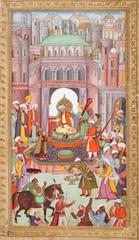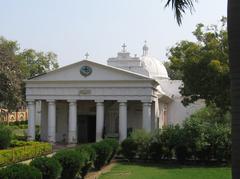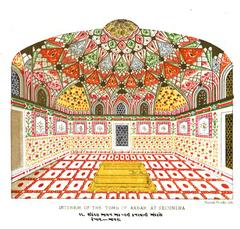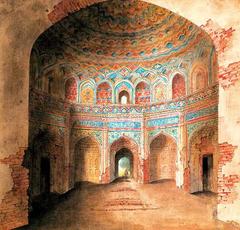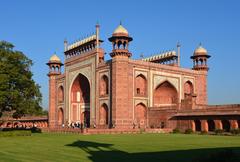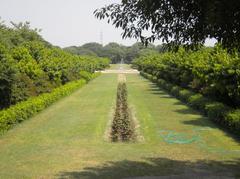Amar Singh Gate: Visiting Hours, Ticket Details, and Comprehensive Guide to Agra’s Historical Sites
Date: 14/06/2025
Introduction
Amar Singh Gate stands as the impressive southern entrance to Agra Fort—one of India’s most significant UNESCO World Heritage Sites and a prime example of Mughal military architecture. Originally constructed during Emperor Akbar’s 16th-century reconstruction of the fort, Amar Singh Gate is both a symbol of historical resilience and a vital access point for millions of visitors each year. Rich in architectural beauty, cultural symbolism, and strategic design, the gate is a must-see for anyone exploring Agra’s historical landscape. This comprehensive guide explores Amar Singh Gate’s history, architectural features, visitor information, nearby attractions, and expert travel tips, ensuring an enriching and seamless experience for travelers and history enthusiasts alike (theworldcastle.com; audiala.com; thomascook.in; rajasthantourdriver.com).
Historical Background
Early Origins
Long before the Mughal era, the site of Agra Fort was home to a brick fortress attributed to the Chauhan and Sikarwar Rajputs. In 1080 AD, the fort was seized by Ghaznavide forces, marking the beginning of a long legacy of conquest and transformation. Its strategic location along the Yamuna River made it a highly coveted stronghold (theworldcastle.com; thehistoryhub.com).
Mughal Expansion and Akbar’s Vision
The turning point came in 1526, when Emperor Babur captured Agra after the First Battle of Panipat. Recognizing its importance, Akbar transformed the dilapidated fort into a grand citadel between 1565 and 1573. The redesign included four main gates, with the southern entrance—originally named Akbar Darwaza (later Amar Singh Gate)—playing a pivotal defensive role. The fort’s semicircular layout, double-battlemented walls, and robust ramparts were all designed for maximum security (culturalindia.net; thecommonwanderer.com; tourguideagra.com; veenaworld.com).
Shah Jahan’s Modifications
Under Shah Jahan, the fort and its gates underwent significant transformation. Shah Jahan introduced the use of white marble and ornate palatial buildings, elevating the fort’s grandeur. The southern gate was renamed Amar Singh Gate in honor of Amar Singh Rathore, a Rajput noble revered for his legendary escape from the Mughal court (wikipedia.org; thrillingtravel.in).
Amar Singh Rathore: Legend and Legacy
The gate’s renaming is tied to Amar Singh Rathore’s dramatic escape after a fatal altercation in Shah Jahan’s court. This act of bravery and resistance was immortalized in local folklore, and the gate’s new name stands as a tribute to Rajput valor (hindupost.in; pathbeat.in).
British Colonial Era
In 1803, the British East India Company occupied Agra Fort, demolishing many Mughal structures for military use. Of the original buildings, only about thirty remain today, primarily on the river-facing side. Despite these changes, Amar Singh Gate continued as a principal entrance and retained its historical and architectural importance (wikipedia.org; culturalindia.net).
Architectural Features
Defensive Design
- Strategic Angling: The gate’s entrance is set at a 90-degree angle to the main wall, preventing direct assaults and thwarting war elephants (thrillingtravel.in).
- Moat and Drawbridge: A wide moat, once filled with crocodiles, surrounds the fort, with entry via a drawbridge that could be raised in times of attack (tourguideagra.com).
- Ramparts and Bastions: Double-layered walls and massive bastions provided vantage points for defenders (samedaytours.in).
Materials and Aesthetics
- Red Sandstone and Marble: The gate is built primarily of red sandstone with white marble inlays, reflecting the Mughal penchant for combining functionality with artistic beauty (thomascook.in).
- Ornamentation: Decorative motifs blend Islamic and indigenous Indian styles, featuring lotus designs, Persian tiles, and intricate inlays.
- Octagonal Watchtowers: These towers not only fortified the gate but also provided sweeping views of the fort’s surroundings.
Access Sequence
Visitors must traverse three gates arranged at right angles, creating a zigzag approach that historically slowed invaders and exposed them to defensive fire (samedaytours.in).
Visitor Information
Visiting Hours
- Open daily: 6:00 AM to 6:00 PM (Sunrise to Sunset)
- Note: Timings may vary during festivals or maintenance periods. Always check official sources in advance.
Ticket Prices
- Indian Citizens: ₹40–50
- Foreign Nationals: ₹550–650
- Children under 15: Free
- Combined Tickets: Available for Agra Fort and Taj Mahal, offering convenience for multi-site visits.
Tickets are available at the Amar Singh Gate counter or online via official portals (veenaworld.com; rajasthantourdriver.com).
Accessibility
- While main pathways are accessible, some areas near the entrance involve steps and steep ascents. Improvements are ongoing, but visitors with mobility challenges may require assistance (audiala.com).
Security and Facilities
- Security Checks: All visitors and bags are screened at entry.
- Facilities: Restrooms, drinking water stations, and information desks are available near the gate.
- Guided Tours: Certified guides and audio guides in multiple languages are available at the entrance (Medium).
Best Time to Visit
- October to March offers the most pleasant weather. Early mornings and late afternoons provide cooler temperatures and softer light for photography.
Travel Tips
- Dress Modestly: For comfort and cultural respect.
- Footwear: Wear sturdy shoes for navigating stone pathways and staircases.
- Photography: Allowed in most areas; professional equipment may require permission.
- Duration: Allocate at least 2–3 hours for a comprehensive visit. Do not bring food inside; only water is allowed.
Guided Tours, Events, and Visitor Experience
- Guided Tours: Enhance your visit with guided tours that provide rich historical context and help you navigate the fort’s complex layout.
- Heritage Walks and Light Shows: Scheduled events such as heritage walks and sound-and-light shows bring the site’s history to life (jaypeehotels.com).
Nearby Historical Sites and Attractions
- Taj Mahal: 2.5 km from Amar Singh Gate; Agra’s most iconic attraction (Rajasthan Tour Driver).
- Mehtab Bagh: Offers panoramic sunset views of the Taj Mahal.
- Jama Masjid: Renowned mosque near Agra Fort (Thrillophilia).
- Tomb of Itimad-ud-Daulah: Known as the “Baby Taj.”
- Akbar’s Tomb, Sikandra: A fusion of Mughal, Hindu, and Persian styles.
- Fatehpur Sikri: UNESCO site 40 km away, home to Buland Darwaza.
- Within Agra Fort: Jahangiri Mahal, Khas Mahal, Musamman Burj, Anguri Bagh.
Frequently Asked Questions (FAQs)
Q: What are the visiting hours for Amar Singh Gate?
A: 6:00 AM to 6:00 PM daily.
Q: Is a separate ticket needed for Amar Singh Gate?
A: No, entry through Amar Singh Gate is included with the Agra Fort ticket.
Q: Is the site wheelchair accessible?
A: Main pathways are accessible, but some areas may present challenges.
Q: Are guided tours available?
A: Yes, certified guides and audio guides can be hired at the entrance.
Q: Can I bring food inside?
A: Food is not allowed; only water is permitted.
Q: Is photography allowed?
A: Yes, but professional equipment may require permission.
Preservation and Sustainability
Agra Fort and Amar Singh Gate are actively preserved by the Archaeological Survey of India and UNESCO. Responsible tourism—including following site rules and supporting conservation efforts—ensures that these monuments remain accessible and inspiring for future generations.
Summary & Visitor Recommendations
Amar Singh Gate embodies the fusion of military genius, artistry, and cultural symbolism that defines Agra’s Mughal heritage. As Agra Fort’s principal entrance, it offers a gateway to centuries of history and a starting point for exploring other monumental sites. With clear visiting hours, affordable ticketing, guided tours, and nearby attractions, Amar Singh Gate is both accessible and rewarding for all visitors. Enhance your experience with digital resources, virtual tours, and the Audiala app for real-time updates and curated content (veenaworld.com; jaypeehotels.com; rajasthantourdriver.com).
References
- Agra Fort: A Marvel of Mughal Architecture (The World Castle)
- Agra Fort Features and Facts (SameDayTours)
- Amar Singh Gate Visiting Hours, Tickets & History | Agra Historical Sites Guide (Audiala)
- Agra Monuments Entrance Fees and Timings (Rajasthan Tour Driver)
- The Mughals & Agra Fort (Astonishing India)
- Complete Travel Guide to Agra Fort (Jaypee Hotels)
- Amar Singh Rathore: The Unbowed Hero Who Challenged an Empire (HinduPost)
- Inside Agra Fort Guide (Thrilling Travel)
- Agra Fort - UNESCO World Heritage Site (Wikipedia)
- Agra Fort Tickets, Visiting Hours & Guide (Veenaworld)
- Things to Do in Agra (Thrillophilia)
